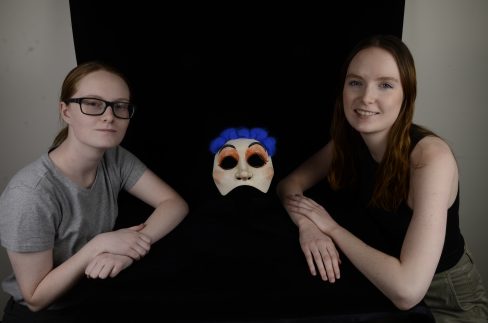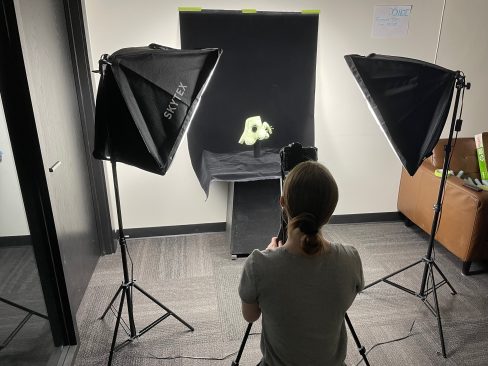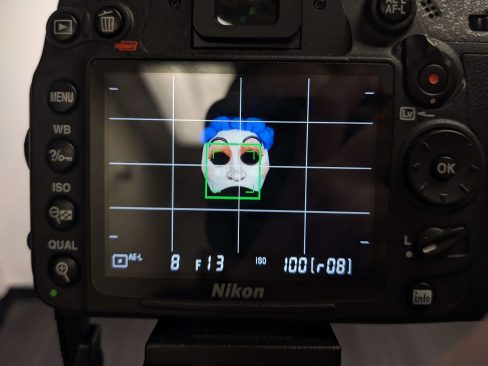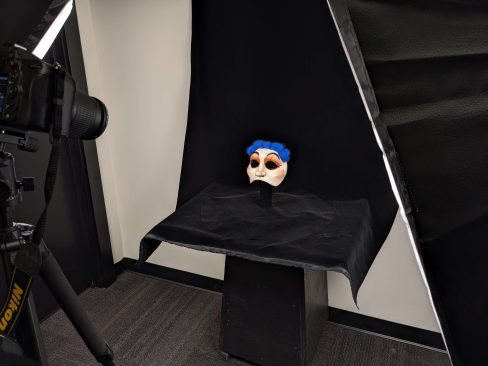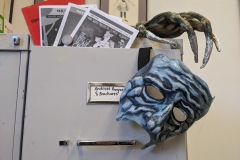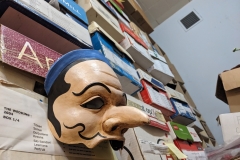Odyssey Theatre has an exceptional collection of theatrical masks created by distinguished mask makers. Since our first show in 1986, Odyssey has amassed over 300 unique masks that reflect the vibrancy of our shows, characters, and artists. Our masks are inspired by the Commedia dell’Arte tradition and bear various influences, including Peking Opera, Wayang Wong, natural elements, and visual art.
This season we finish cataloguing our extraordinary collection of more than 300 hand-crafted masks by Canada’s top mask creators. We are grateful for the assistance of interns from the Public History Department at Carleton University.
We also begin building a museum unlike any other. Launching in 2027, this digital experience will be accessible to all and serve as a resource for educators, theatre students and professionals.
This digital museum will offer new videos and rare photos from the world of masked theatre. Visitors will be able to explore our masks, learn how to make them and discover how to work with masks in performance.
Stay tuned for announcements about the evolution of this project.
Venture Behind the Scenes!
Sarah has been writing about her experience cataloguing the mask collection. Follow along by reading what she’s had to say about the project so far:
“In my placement with Odyssey Theatre, I am assisting with their mask accessioning project, helping catalogue and create a digital archive/collection of their extensive mask collection. With over three hundred masks used since Odyssey’s first mask performance with The King Stag (1987), the work that has gone into and will continue to go into this project is extensive, and once finished, will be very rewarding.
The process of the project involves going through each performance Odyssey has done featuring masks, photographing, measuring, and recording additional information for each mask. Each mask had five accompanying photos at various angles, some with seven or eight depending on the size and design. Some masks have additional pieces, such as beards, hats, and head pieces, which require additional work to properly set up and adjust during the photography process. Along with mention of those extra pieces, information such as the actor/actress who performed the mask, the mask creator, and the inspiration for the mask design are all also recorded in one place for easy access.
Each mask has a lot of information associated with it and a deep creative history; the processes of creating, learning, and performing each mask involves several individuals and a significant amount of time and dedication, all of which is honoured in this project.
Getting the opportunity to work with Odyssey Theatre so far has been thrilling. It has been a great way to make connections with the skills and ways of thinking I have adopted and learned in the process of obtaining my undergraduate degree and has given me related employment experience to my future employment interests.
I am incredibly grateful for Odyssey in giving me the opportunity to work with them on this exciting project. Getting to learn a great deal in the process about photography, Commedia dell’Arte and the rich history of Odyssey has been rewarding and exciting as a student who is eager to learn!”
“In my time with Odyssey Theatre, we have made great progress in photographing for the mask accessioning project. The many hours of work put into the project thus far have resulted in hundreds of photos being taken, many measurements being recorded, and extensive information put into an associated spreadsheet for the project. After dozens of hours since the beginning of January, we have almost finished taking photos of all of the masks in the collection.
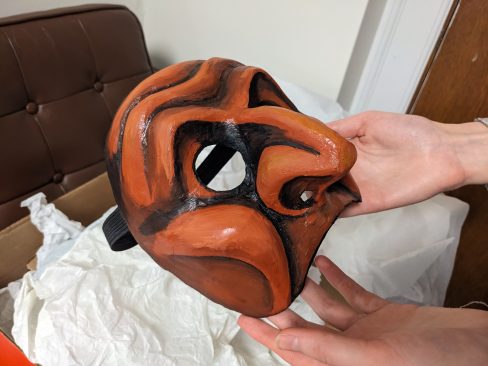 Like any project, we have dealt with both challenges and successes. With some masks or extra pieces associated with the masks being missing/in an unknown location, uncooperative tape that we rely on to keep the masks in place, and the occasional struggle with bigger, more detailed mask/headpieces taking longer to set up and photograph, at times the process goes a bit slower. Despite these challenges, we have been ahead of schedule so far, giving us time to re-take photos if needed later.
Like any project, we have dealt with both challenges and successes. With some masks or extra pieces associated with the masks being missing/in an unknown location, uncooperative tape that we rely on to keep the masks in place, and the occasional struggle with bigger, more detailed mask/headpieces taking longer to set up and photograph, at times the process goes a bit slower. Despite these challenges, we have been ahead of schedule so far, giving us time to re-take photos if needed later.
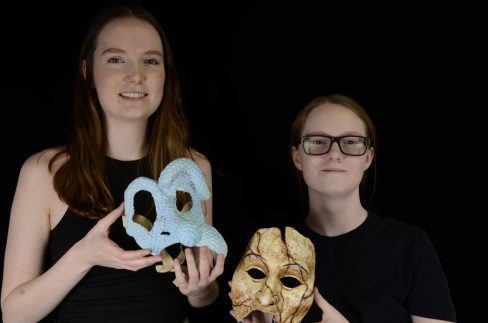 The work that I have done so far with Odyssey echoes the work done by many museums across the country and around the world, either related to theatre or not. Digital museums and exhibitions require a lot of the same work of photography, measuring, and cataloguing. Museums use these to present items with an end goal of education and documentation, both of which are important in maintaining public memory and public interest. Documenting things in photographic form preserves their memory, and getting to participate in that kind of work with Odyssey is something that I value a lot both on a personal and intellectual level.
The work that I have done so far with Odyssey echoes the work done by many museums across the country and around the world, either related to theatre or not. Digital museums and exhibitions require a lot of the same work of photography, measuring, and cataloguing. Museums use these to present items with an end goal of education and documentation, both of which are important in maintaining public memory and public interest. Documenting things in photographic form preserves their memory, and getting to participate in that kind of work with Odyssey is something that I value a lot both on a personal and intellectual level.
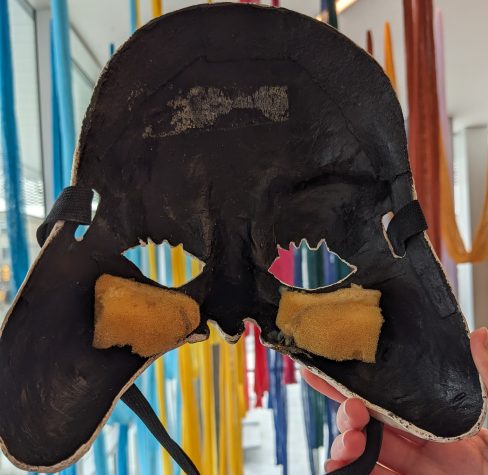 Alongside the physical process of the project itself, getting to learn from Creative Director Laurie Steven every week about the history behind the masks, the historical inspiration for them (often across theatre traditions), and the ways in which stock characters and their characteristics find their inspiration historically is something that I am very grateful for.
Alongside the physical process of the project itself, getting to learn from Creative Director Laurie Steven every week about the history behind the masks, the historical inspiration for them (often across theatre traditions), and the ways in which stock characters and their characteristics find their inspiration historically is something that I am very grateful for.
There is still lots of work to go, and although I am only working with Odyssey until the beginning of April for this placement, I am honoured to have helped bring the project to this point!”
As I end my time with Odyssey, I am proud of all the work we have done. It has required a lot of creativity, patience, and time to get to this point, and the hardest work is nearly completed. Since my last post, we have completed several reshoots and gained materials that have helped with that process. We also have dealt with the most difficult photography by far, such as the Goddess mask and headpiece from Odyssey’s 2018 performance Lysistrata, an endeavour that took about an hour of set up time and some creativity to achieve.
 To connect what I have done thus far with my history degree, the photography we have done is also an act of digital preservation. By photographing all these masks, we preserve their likeness in a form that is accessible from beyond their physical storage space. We have also consolidated other relevant pieces of information for each mask that are found in boxes, drawers, and binders across Odyssey’s storage space for the same purpose in the process of this project. This practice of digital archiving is along the same practices done by museums and other organizations for purposes of preservation.
To connect what I have done thus far with my history degree, the photography we have done is also an act of digital preservation. By photographing all these masks, we preserve their likeness in a form that is accessible from beyond their physical storage space. We have also consolidated other relevant pieces of information for each mask that are found in boxes, drawers, and binders across Odyssey’s storage space for the same purpose in the process of this project. This practice of digital archiving is along the same practices done by museums and other organizations for purposes of preservation.
This project also goes beyond preservation, touching on the global connections Odyssey has. Many of the performances incorporate performance styles from various cultures and take inspiration from the stories around the world, and they have resulted in collaborations with world renowned individuals in the realm of theatre and dramaturgy.
 Even further, many individuals had their careers boosted through working with Odyssey and went on to work with world-renowned organizations and companies. Ross Mullan, Jesse Buck, and Andy Massingham for example are some actors who have gone onto work in both television and world-renowned performance companies. This shows that this kind of work has significant cultural relevance and connections on a local, national, and international scale; These masks go beyond simply their appearance and creation in ways that are far reaching.
Even further, many individuals had their careers boosted through working with Odyssey and went on to work with world-renowned organizations and companies. Ross Mullan, Jesse Buck, and Andy Massingham for example are some actors who have gone onto work in both television and world-renowned performance companies. This shows that this kind of work has significant cultural relevance and connections on a local, national, and international scale; These masks go beyond simply their appearance and creation in ways that are far reaching.
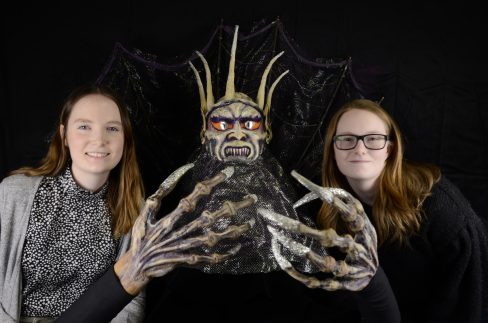 Thank you once again to Odyssey Theatre and to Carleton University’s history department for giving me the wonderful opportunity to contribute to this amazing project. Opportunities like the Practicum in History, through which I was able to contribute to this project, are incredibly valuable for students like me to have access to. I am once again grateful for the experience, and very thankful of what I have learned.
Thank you once again to Odyssey Theatre and to Carleton University’s history department for giving me the wonderful opportunity to contribute to this amazing project. Opportunities like the Practicum in History, through which I was able to contribute to this project, are incredibly valuable for students like me to have access to. I am once again grateful for the experience, and very thankful of what I have learned.

